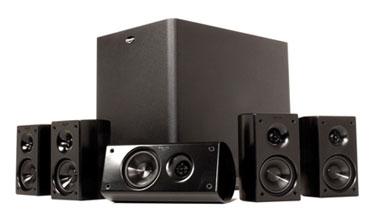Klipsch HD Theater 300

| The Short Form |
| $400 / KLIPSCH.com |
| Snapshot |
| A compact system that delivers true 5.1 surround sound for not a whole lot of cash. |
| Plus |
| • Tiny satellites all but disappear in your room • Very affordable |
| Minus |
| • Limited dynamics rule out big rooms • Needs careful setup for best performance • Requires extensive break-in to sound good |
| Key Features |
| • Satellites 3/4-in horn tweeter, 2 1/2-in cone woofer; 5 1/2 in high, 1 1/2 lb • Center 3/4-in horn tweeter, 2 1/2-in cone woofer; 7 1/2 wide, 2 3/4 pounds • Subwoofer 6 1/2-in cone woofer, 80-watt amplifier; 11 3/4 x 10 x 14 1/2 in high, 19 1/2 lb |
"Where are the horns?" That was my friend Brian's initial reaction when he stopped by to check out the Klipsch HD Theater 300. Like many audiophiles, Brian associates the Klipsch brand with the huge, room-filling horn speakers that first put the company on the map. But the speakers that make up the HD Theater 300 are not only free of visible horns but also tiny. To put things in perspective, Klipsch introduced a speaker in the mid-1950s called the Heresy, so called because it abandoned the brand's traditional horn-loaded woofer for the sake of compactness. But today an entire HD Theater 300 speaker system could fit inside a single Heresy with plenty of room to spare.
Technically, the HD Theater 300's satellite speakers can still actually be called horns, although at this point the horn part has been reduced to a small, round Micro-Tractix lens surrounding the tweeter. With four identical satellites for front and surround channels, a slightly larger center speaker, and a very compact powered subwoofer, the HD 300 is easily Klipsch's smallest 5.1 home theater speaker system yet. And at $400, it's also priced lower than just about any similar brand-name speaker package.
Each of the system's molded plastic satellites is about the same size as a can of soda, but with a little more girth. A removable grille covers a 2.5-inch woofer and a 3/4-inch tweeter, while a pair of spring-clip terminals around the back will accept up to 16-guage bare wire. With each speaker weighing just a few pounds, wall mounting is a definite option. To that end, Klipsch includes a plastic mount that allows the satellites to be swiveled toward the listening position for optimal imaging. The center speaker is really just a slightly longer version of the other satellites. Along with the wall bracket, it includes a plastic cradle that allows its rounded shape to sit flat on a shelf without rocking.
Since itty-bitty satellites can't reach very deep into the bass, any subwoofer you match with them will have to cover a lot of sonic ground. The HD Theater 300's Sub 6 uses an 80-watt amplifier to drive a 6.5-inch woofer in a ported enclosure, and it has the demanding task of providing all of the system's sound from about 150 Hz down. In addition to a level control and line- and speaker-level inputs, it has a phase-reversal switch and a non-bypassable low-pass filter crossover. A signal-sensing power mode turns the sub on and off as needed so you can just set it and forget it.
SETUP
One method for getting decent performance from a system this small is to try to maximize each speaker's output by using your room's walls to "boundary load" the sound. This means putting the subwoofer in a front corner of the room, and placing the satellites right up against the walls. I placed the front and center speakers evenly spaced under the bottom edge of my projection screen, and then put the surround speakers in their normal places on the walls directly to the side about 2 feet above the listening position.
Choosing an optimum crossover point on you receiver is especially important with a system like this, as there is rarely much overlap between the satellites' low frequency limit and the sub's upper reach. The Sub 6's crossover doesn't make the process easier: Even when turned to its highest setting (marked as 160 Hz, but in reality, somewhat higher), I found it tough to avoid a hole in the system's upper-bass response. I eventually settled on my receiver's 150-Hz setting, with the sub's crossover frequency control cranked all the way up.
Audiophiles often argue about the merits of break-in -- that is, whether audio gear really needs a few miles of ride time to sound its best. The HD 300 system makes a strong argument for break-in, as its sound clearly went from being nasty and peaky to smoother and more refined following a couple hundred hours of heavy use.
- Log in or register to post comments




















































